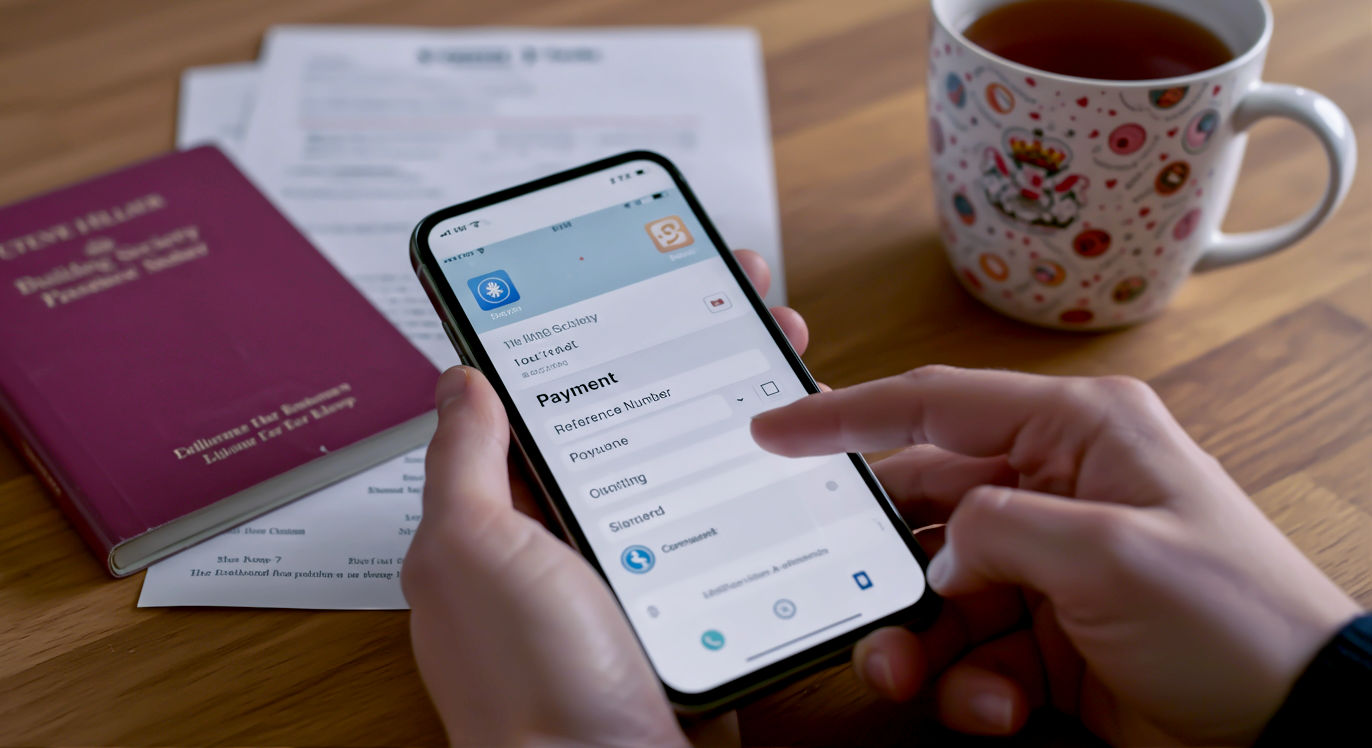Building Society Reference Numbers: The Guide to What They Are and How to Use Them
Ever been stuck on a payment asking for a ‘reference number’? This definitive guide demystifies the building society roll number, showing you exactly how it works.

This post may contain affiliate links. If you make a purchase through these links, we may earn a commission at no additional cost to you.
Ever been there? You’re trying to send some birthday money from your mum, or maybe your first paycheque, over to your new building society savings account. You’re filling in the details on your banking app – name, sort code, account number – and then you hit a box that says ‘Reference’.
You stop. What on earth is that? You check your building society welcome letter. There’s a long string of numbers, but it’s not labelled ‘Account Number’. Is that it? You start to worry. If you get it wrong, will your money disappear into a black hole?
Relax. You’re not alone, and it’s much simpler than it looks. That little box is asking for your building society reference number, and it’s the single most important key to making sure your money lands safely in your account.
For decades, building societies have been a cornerstone of British financial life, helping people save for a rainy day and buy their first homes. They work a little differently from the big high-street banks, and this reference number is a perfect example of that unique character.
This guide will tell you everything you’ll ever need to know. We’ll break down what this number is, why it exists, where to find it, and exactly how to use it without a single bead of sweat. By the end, you’ll be handling your transactions like a pro, and that little ‘Reference’ box will never worry you again.
What Exactly is a Building Society Reference Number?
Think of it this way. Your building society is like a huge block of flats. All the post for every resident gets delivered to the main address at the front door. But for your letters to get to you, the postman needs to know your specific flat number.
That’s your reference number. It’s your account’s unique flat number.
It’s Your Account’s Unique Nickname
Most building societies in the UK operate with a central, or ‘pooled’, bank account. This means thousands of customers—people just like you—all send their money to the same sort code and account number. This single account is the main entrance to the block of flats.
When your money arrives, the building society’s systems look at the reference you included with the payment. That reference—sometimes called a roll number or simply your account number—is the unique code that tells them, “Aha! This £50 is for Sarah Jones’s rainy-day fund,” or “This £800 is for David Smith’s mortgage payment.”
Without it, your money is just an anonymous deposit sitting in a massive pot with everyone else’s. The reference number acts as a tag, ensuring your funds are instantly routed to the right place: your personal account.
In short: The building society has one main bank account, and your reference number directs money from that main account into your specific savings pot or mortgage account.
Why Don’t Building Societies Just Use Regular Account Numbers?
This is a great question, and the answer lies in their history. Building societies were originally formed as mutual institutions in the 18th and 19th centuries. They were communities of people pooling their savings to help each other buy homes, long before modern banking technology existed.
Their systems were built around this collective model. The idea of a single, central treasury—the pooled account—was efficient and simple. Each member was given a number on the society’s roll call (hence the name ‘roll number’) to track their contributions.
While the technology has obviously moved on a bit since the days of quill pens and ledgers, the basic structure has remained for many savings and mortgage accounts because it’s a robust and proven system. It works perfectly well, so for many societies, there’s been no pressing need to change it.
In contrast, modern banks were built from the ground up to give every single customer a unique sort code and account number for their current account. Some larger building societies, like Nationwide, now do this for their current accounts to make them work just like a bank account, but the traditional roll number system is still the backbone for millions of savings and mortgage accounts across the country.
Where Can I Find My Reference Number? It’s Closer Than You Think
Right, let’s get this sorted. You need your number, and you need it now. The good news is that your building society makes sure it’s available in several places. You’ve probably seen it dozens of times without realising what it was.
Your Paper Trail: Statements and Welcome Packs
The most reliable place to find your reference number is on your official paperwork.
- Annual Statements: Dig out the last paper statement your building society sent you. Look at the top right-hand corner, usually near your name and address. You’ll see a number labelled ‘Account Number’ or ‘Reference Number’. It’s often a mix of letters and numbers, or a long string of digits. That’s your golden ticket.
- Welcome Letter: When you first opened your account, you would have received a welcome pack. The letter confirming your account was set up will have the reference number printed clearly on it. It’s always worth keeping this safe.
The Old-School Classic: Your Passbook
If you have a traditional passbook savings account, your reference number is right there in the book. It’s usually printed on the first page or on a sticker inside the cover, along with your name. A passbook is a physical record of your savings, and your all-important roll number is its central identifier.
Logging In: Online Banking and Mobile Apps
For those who’ve gone digital, finding your number is just a few clicks or taps away.
- Log in to your building society’s online banking portal or mobile app.
- Navigate to your account. Click on the savings or mortgage account you want to find the number for.
- Look for ‘Account Details’. There should be a link or a button that says something like ‘View account details’, ‘More information’, or simply an ‘i’ icon.
- Find your number. In that section, you’ll see a breakdown of your account information. Your reference number will be listed there, often called ‘Account Number’ or ‘Roll Number’.
Because every app and website is slightly different, you might have to poke around a little, but it will absolutely be in the main details section for your chosen account.
When in Doubt, Give Them a Bell
If all else fails and you simply can’t find it, don’t guess. The safest thing to do is call your building society’s customer service helpline. After you pass their security questions (to prove you are who you say you are), they’ll be able to tell you your reference number over the phone.
Keep it safe once you have it. Maybe jot it down in a secure note on your phone or save the details of your building society as a ‘Payee’ in your main bank’s app, so you don’t have to hunt for it every time.
Putting Your Reference Number to Work: A Practical Guide
Now you’ve found your number, it’s time to use it. This is where people sometimes stumble, but it’s easy once you know the formula. Let’s walk through the most common scenarios.
Sending Money to Your Savings or Current Account
You’re logged into your main bank (e.g., Barclays, Lloyds, Monzo) and want to send money to your building society account. You’ll choose to make a new payment and be faced with a form. Here’s how you fill it in:
- Payee Name: This is the official name of your building society. For example, ‘Yorkshire Building Society’ or ‘Coventry Building Society’.
- Sort Code: This is the building society’s central sort code. You can find this on their website under a section like ‘Making payments to your account’. It’s the same for every customer sending money to that type of account.
- Account Number: This is the building society’s central bank account number. Again, this is a generic number for the main pooled account.
- Reference: This is where you put your unique roll number. Triple-check you’ve typed it correctly. This is the part that tells the society the money is for you.
Crucial Tip: The ‘Account Number’ you enter is the building society’s, not yours. Your personal identifier goes only in the ‘Reference’ field. Getting this wrong is the number one mistake people make.
Once you’ve sent the payment, the Faster Payments system will whizz it over to the building society’s central account within seconds. Their automated systems then scan the reference, identify your account, and credit the money to your balance. The whole process is usually seamless and takes just a few minutes.
Paying Your Mortgage
This is another common use for a reference number, but with a critical difference. Your mortgage roll number is almost always different from your savings roll number.
When making a mortgage payment (perhaps an overpayment), you must use the specific roll number associated with your mortgage. You’ll find this on your annual mortgage statement or in the mortgage section of your online banking.
Using your savings reference for a mortgage payment by mistake will cause confusion. The payment might be rejected, or it could be accidentally credited to your savings, meaning you haven’t technically paid your mortgage. Always double-check you’re using the right number for the right account.
Setting Up Direct Debits and Standing Orders
The principle is exactly the same for automated payments.
- Standing Orders: If you’re setting up a standing order to regularly move money into your savings, you’ll use the same four pieces of information: the society’s name, their central sort code and account number, and your personal roll number in the reference field.
- Direct Debits: When you set up a Direct Debit to pay a bill from your building society account, the company you’re paying will ask for your details. You’ll provide them with your reference number, which allows them to correctly identify your account when they request the funds.
Common Blunders and How to Dodge Them
Thousands of transactions happen smoothly every day using reference numbers. But when things go wrong, it’s usually down to one of these simple, avoidable slip-ups.
Mistake 1: Leaving the Reference Field Blank
This is the most common mistake. If you send a payment without a reference, your money will arrive at the building society’s central account, but they will have absolutely no idea who it belongs to.
- What Happens: The money will sit in a ‘suspense account’ while the society’s team tries to figure out where it came from. This can take days or even weeks. Eventually, if they can’t identify the sender or intended recipient, they will return the money to the sending bank. Your payment will be seriously delayed, which could be a problem if it’s for a bill or a mortgage.
Mistake 2: Putting Your Reference in the Wrong Box
Some people see the ‘Account Number’ field and, logically, put what they think is their account number (the reference) into it.
- What Happens: The payment will fail instantly. The sending bank’s system will try to validate the sort code and account number combination. Since your personal roll number isn’t the building society’s real central account number, the details won’t match, and the payment will be rejected before it even leaves your bank. This is frustrating, but it’s safer than the money going missing.
Mistake 3: Using the Wrong Number
It’s easy to do, especially if you have multiple accounts with the same building society.
- What Happens: You might send your mortgage overpayment to your savings account, or vice-versa. Usually, this is fixable. You’ll need to contact the building society, explain what happened, and ask them to perform an internal transfer from the wrong account to the right one. It’s a bit of a faff but generally resolvable.
What to Do If You’ve Made a Mistake
Don’t panic. Your money is very rarely ‘lost’ forever. The UK banking system has processes for these situations.
- Contact the bank you sent the money FROM. Tell them you’ve made a payment with an incorrect reference. They may be able to initiate a trace or provide more details.
- Contact your building society. This is the most important step. Give them a call and explain what’s happened. Be ready to provide the exact date, time, and amount of the payment, the sort code and account number you sent it to, and the (incorrect) reference you used.
- Be patient. It can take a few days for the funds to be located and correctly allocated, but the staff are used to dealing with this. The more information you can provide, the quicker they can sort it for you.
Are Reference Numbers Here to Stay?
As the financial world becomes more digital, are roll numbers a relic of the past? Well, yes and no.
The Shift to Unique Account Numbers
You’ve probably noticed that some building societies are starting to behave more like banks. Nationwide, the UK’s largest building society, now issues a unique account number and sort code for its current accounts. This makes it much easier for customers to receive payments, as they no longer need to worry about a reference. It simplifies everything and aligns with modern payment systems like Confirmation of Payee, which checks that the account name matches the account number before a payment is sent.
More societies are likely to follow this trend, especially for their everyday banking and current accounts.
Why They Still Matter for Savings and Mortgages
However, for millions of existing savings and mortgage accounts, the roll number system isn’t going anywhere soon. The underlying infrastructure is deeply embedded in the societies’ systems. Changing it would be a massive, expensive, and complex project.
Since the current system works efficiently for its purpose—crediting deposits and logging mortgage payments—there is little incentive to change it. So, for the foreseeable future, your trusty reference number will remain a key part of managing your savings and mortgage with a building society.
Conclusion: Your Reference Number is Your Financial Fingerprint
That string of numbers you were once worried about is, in fact, incredibly simple. It’s your unique financial fingerprint within your building society. It’s the small but mighty instruction that ensures your hard-earned cash always finds its way home.
By understanding what it is and how to use it, you’ve unlocked a core piece of how British building societies work.
So, the next time you see that ‘Reference’ box, you’ll know exactly what to do. Find your roll number, pop it in, and send your payment with confidence. You’ve got this sorted.
Further Reading:
- Building Societies Association (BSA): https://www.bsa.org.uk/
- MoneySavingExpert – Banking & Savings: https://www.moneysavingexpert.com/savings/
- Which? Money – Savings: https://www.which.co.uk/money/savings-and-isas
- Pay.UK – Faster Payments: https://www.wearepay.uk/what-we-do/payment-systems/faster-payment-system/






